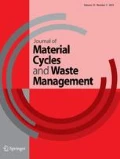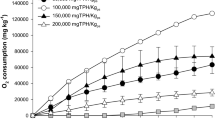Abstract
Abstract
The outcome of different processes in oil refineries is production of hazardous wastes containing toxic and hardly degradable compounds. Use of chemical processes before bioremediation for faster degradation of heavy and hardly biodegradable compounds can be a solution to enhance the degradability of oily sludge. Thus, the aim of the present study is to investigate the efficiency by ozone oxidant in enhancing the degradability of TPH in oily sludge. The design of experiments of ozonation process was under different conditions with the one-factor-at-a-time approach. The concentration of the oily hydrocarbons was determined using gravimetric method. The results indicated that the optimal conditions for TPH removal by ozonation process involved pH = 11, within 4 h with ozone concentration of 10 mg/min, which output an efficiency of 23.8%. Results showed the TPH degradation by ozonation process was well fitted to pseudo-first-order kinetic model with determination coefficient of more than 97%. This study indicated that chemical treatment alone cannot guarantee the treatment of TPH under typical conditions. However, reducing the amount of compounds with higher molecular weight and predominating compounds with lower carbon content is an effective option to enhance the degradability of compounds with high molecular weight as a pretreatment for biological processes.
Graphical abstract

Article Highlights
-
Ozonation process was tested for TPH degradation in oily sludge.
-
The Gravimetric method was used to determine the concentration of TPH and Iatroscan TLC-FID was used for SARA analysis.
-
The GC-FID was used to determine the PHCs fraction analysis.
-
The ozonation process is an effective method for increasing the degradability of TPH in oily sludge.
-
The TPH degradation was more consistent with the ozonation process with a coefficient of more than 97% with pseudo first order reactions.




Similar content being viewed by others
References
Kulikowska D (2016) Kinetics of organic matter removal and humification progress during sewage sludge composting. Waste Manag 49:196–203
Varjani SJ (2017) Microbial degradation of petroleum hydrocarbons. Bioresour Technol 223:277–286
Rodrigo J, Boltes K, Esteve-Nuñez A (2014) Microbial-electrochemical bioremediation and detoxification of dibenzothiophene-polluted soil. Chemosphere 101:61–65
Sabina K, Fayidh MA, Archana G, Sivarajan M, Babuskin S, Babu PAS et al (2014) Microbial desalination cell for enhanced biodegradation of waste engine oil using a novel bacterial strain Bacillus subtilis moh3. Environ Technol 35(17):2194–2203
Ramaswamy B, Kar D, De S (2007) A study on recovery of oil from sludge containing oil using froth flotation. J Environ Manag 85(1):150–154
Ubani O, Atagana H, Thantsha MS (2013) Biological degradation of oil sludge: a review of the current state of development. Afr J Biotech 12(47):6544–6567
EPA S. Environmentally acceptable resources recovery from oil refinery sludge. US Environmental Protection Agency (EPA), Washington DC. 1991
Mrayyan B, Battikhi MN (2005) Biodegradation of total organic carbons (TOC) in Jordanian petroleum sludge. J Hazard Mater 120(1–3):127–134
Reddy MV, Devi MP, Chandrasekhar K, Goud RK, Mohan SV (2011) Aerobic remediation of petroleum sludge through soil supplementation: microbial community analysis. J Hazard Mater 197:80–87
Gallego JLR, García-Martínez MJ, Llamas JF, Belloch C, Peláez AI, Sánchez J (2007) Biodegradation of oil tank bottom sludge using microbial consortia. Biodegradation 18(3):269–281
Koolivand A, Naddafi K, Nabizadeh R, Nasseri S, Jafari AJ, Yunesian M (2013) Biodegradation of petroleum hydrocarbons of bottom sludge from crude oil storage tanks by in-vessel composting. Toxicol Environ Chem 95(1):101–109
Ying-Xin G, Ran D, Xing C, Zhao-Bo G, Yu Z, Min Y (2018) Ultrasonic washing for oily sludge treatment in pilot scale. Ultrasonics 90(3):1–4
Naddafi K, Nabizadeh R, Jonidi JA, Yaghmaeian K, Koulivand A (2014) Efficiency of chemical oxidation of composted sludge of crude oil using hydrogen peroxide and Fenton. Arak Med Univ J 16(81):75–86
Bhupathiraju VK, Krauter P, Holman H-YN, Conrad ME, Daley PF, Templeton AS et al (2002) Assessment of in-situ bioremediation at a refinery waste-contaminated site and an aviation gasoline contaminated site. Biodegradation 13(2):79–90
Van Hamme JD, Singh A, Ward OP (2003) Recent advances in petroleum microbiology. Microbiol Mol Biol Rev 67(4):503–549
Biswal BK, Tiwari SN, Mukherji S (2009) Biodegradation of oil in oily sludges from steel mills. Bioresour Technol 100(4):1700–1703
Mohanty G, Mukherji S (2008) Biodegradation rate of diesel range n-alkanes by bacterial cultures Exiguobacterium aurantiacum and Burkholderia cepacia. Int Biodeterior Biodegrad 61(3):240–250
Gojgic-Cvijovic G, Milic J, Solevic T, Beskoski V, Ilic M, Djokic L et al (2012) Biodegradation of petroleum sludge and petroleum polluted soil by a bacterial consortium: a laboratory study. Biodegradation 23(1):1–14
Peters KE, Peters KE, Walters CC, Moldowan J (2005) The biomarker guide. Cambridge university press, Cambridge
Moussavi G, Ghorbanian M (2015) The biodegradation of petroleum hydrocarbons in an upflow sludge-blanket/fixed-film hybrid bioreactor under nitrate-reducing conditions: performance evaluation and microbial identification. Chem Eng J 280:121–131
Guangji Hu, Li J, Guangming Z (2013) Recent development in the treatment of oily sludge from petroleum industry: a review. Int J Chem Sci 261(4):470–490
Ghorbanian M, Moussavi G, Farzadkia M (2014) Investigating the performance of an up-flow anoxic fixed-bed bioreactor and a sequencing anoxic batch reactor for the biodegradation of hydrocarbons in petroleum-contaminated saline water. Int Biodeterior Biodegrad 90:106–114
Moussavi G, Mahmoudi M (2009) Degradation and biodegradability improvement of the reactive red 198 azo dye using catalytic ozonation with MgO nanocrystals. Chem Eng J 152(1):1–7
Zhang J, Li J, Thring RW, Hu X, Song X (2012) Oil recovery from refinery oily sludge via ultrasound and freeze/thaw. J Hazard Mater 203:195–203
Hoseinzadeh E, Rezaee A, Farzadkia M (2017) Enhanced biological nitrate removal by alternating electric current bioelectrical reactor. J Mol Liq 246:93–102
Charinpanitkul T, Limsuwan P, Chalotorn C, Sano N, Yamamoto T, Tongpram P et al (2010) Synergetic removal of aqueous phenol by ozone and activated carbon within three-phase fluidized-bed reactor. J Ind Eng Chem 16(1):91–95
Taha M, Coutinho JAP (2016) Organic-phase biological buffers for biochemical and biological research in organic media. J Mol Liq 221:197–205
Farzadkia M, Ghorbanian M, Biglari H, Gholami M, Mehrizi EA (2018) Application of the central composite design to optimization of petroleum hydrocarbons removal from oilfield water using advanced oxidation process. Arch Environ Prot 44(4):20–30
Adeniji A, Okoh O, Okoh A (2017) Analytical methods for the determination of the distribution of total petroleum hydrocarbons in the water and sediment of aquatic systems: a review. J Chem
Association APH, Association AWW, Federation WPC, Federation WE (1915) Standard methods for the examination of water and wastewater: American Public Health Association
EPA, California Environmental Protection Agency (2006) California petroleum refinery hazardous waste source assessment report. Department of Toxic Substances Control. Office of Pollution Prevention and Technology Development
Reynolds VR, Heuer SR (1993) Process for the recovery of oil from waste oil sludges. Google Patents
Tahhan RA, Ammari TG, Goussous SJ, Al-Shdaifat HI (2011) Enhancing the biodegradation of total petroleum hydrocarbons in oily sludge by a modified bioaugmentation strategy. Int Biodeterior Biodegrad 65(1):130–134
Mohan SV, Chandrasekhar K (2011) Self-induced bio-potential and graphite electron accepting conditions enhances petroleum sludge degradation in bio-electrochemical system with simultaneous power generation. Bioresour Technol 102(20):9532–9541
Liu W, Wang X, Wu L, Chen M, Tu C, Luo Y et al (2012) Isolation, identification and characterization of Bacillus amyloliquefaciens BZ-6, a bacterial isolate for enhancing oil recovery from oily sludge. Chemosphere 87(10):1105–1110
Liu W, Luo Y, Teng Y, Li Z, Ma LQ (2010) Bioremediation of oily sludge-contaminated soil by stimulating indigenous microbes. Environ Geochem Health 32(1):23–29
Wu M, Dick WA, Li W, Wang X, Yang Q, Wang T et al (2016) Bioaugmentation and biostimulation of hydrocarbon degradation and the microbial community in a petroleum-contaminated soil. Int Biodeterior Biodegrad 107:158–164
Jiang C, Larter SR, Noke KJ, Snowdon LR (2008) TLC–FID (Iatroscan) analysis of heavy oil and tar sand samples. Org Geochem 39(8):1210–1214
Nakata S-I, Yamamoto S, Takahashi H, Shiroto Y (1987) Rapid trace analysis of hydrocarbon types for heavy oils by TLC/FID using silica-rod combined with FI–MS. J Jpn Pet Inst 30(6):431–438
Mishra S, Lal B, Jyot J, Rajan S, Khanna S, Kuhad RC (1999) Field study: in situ bioremediation of oily sludge contaminated land using” Oilzapper”. Hazard Ind Wastes 31:177–186
Van Hamme JD, Odumeru JA, Ward OP (2000) Community dynamics of a mixed-bacterial culture growing on petroleum hydrocarbons in batch culture. Can J Microbiol 46(5):441–450
Ward O, Singh A, Van Hamme J (2003) Accelerated biodegradation of petroleum hydrocarbon waste. J Ind Microbiol Biotechnol 30(5):260–270
Kriipsalu M, Marques M, Maastik A (2008) Characterization of oily sludge from a wastewater treatment plant flocculation-flotation unit in a petroleum refinery and its treatment implications. J Mater Cycles Waste Manag 10(1):79–86
Tavassoli T, Mousavi S, Shojaosadati S, Salehizadeh H (2012) Asphaltene biodegradation using microorganisms isolated from oil samples. Fuel 93:142–148
Rondón M, Bouriat P, Lachaise J, Salager J-L (2006) Breaking of water-in-crude oil emulsions. 1. Physicochemical phenomenology of demulsifier action. Energy Fuels 20(4):1600–1604
Da Rocha ORS, Dantas RF, Duarte MMMB, Duarte MML, Da Silva VL (2010) Oil sludge treatment by photocatalysis applying black and white light. Chem Eng J 157(1):80–85
Roldán-Carrillo T, Castorena-Cortés G, Zapata-Peñasco I, Reyes-Avila J, Olguín-Lora P (2012) Aerobic biodegradation of sludge with high hydrocarbon content generated by a Mexican natural gas processing facility. J Environ Manag 95:S93–S98
Marín JA, Moreno JL, Hernandez T, García C (2006) Bioremediation by composting of heavy oil refinery sludge in semiarid conditions. Biodegradation 17(3):251–261
Admon S, Green M, Avnimelech Y (2001) Biodegradation kinetics of hydrocarbons in soil during land treatment of oily sludge. Biorernediation J 5(3):193–209
Robertson SJ, McGill WB, Massicotte HB, Rutherford PM (2007) Petroleum hydrocarbon contamination in boreal forest soils: a mycorrhizal ecosystems perspective. Biol Rev 82(2):213–240
Al-Mutairi N, Bufarsan A, Al-Rukaibi F (2008) Ecorisk evaluation and treatability potential of soils contaminated with petroleum hydrocarbon-based fuels. Chemosphere 74(1):142–148
Khatib Z, Verbeek P (2003) Water to value-produced water management for sustainable field development of mature and green fields. J Petrol Technol 55(01):26–28
Judd S, Jefferson B (2003) Membranes for industrial wastewater recovery and re-use. Elsevier, Amsterdam
Aghapour AA, Moussavi SG, Yaghmaeian K (2015) Application of ozone for, THE removal of catechol fromaquatic environment. J Urmia Univ Med Sci 26(7):561–570
Gozan M (2014) Oil extraction from oil sludge and TPH elimination of solids/water by ozonation. Energy Environ Res 4(2):22
TEPA (Taiwan Environmental Protection Administration) (2003) A research on the determination of the TPHs pollution levels in soil. Technical Report, Taiwan
Sarkar D, Ferguson M, Datta R, Birnbaum S (2005) Bioremediation of petroleum hydrocarbons in contaminated soils: comparison of biosolids addition, carbon supplementation, and monitored natural attenuation. Environ Pollut 136(1):187–195
Zhang J, Li J, Thring R, Liu L (2013) Application of ultrasound and Fenton’s reaction process for the treatment of oily sludge. Procedia Environ Sci 18:686–693
Lu M, Zhang Z, Qiao W, Wei X, Guan Y, Ma Q et al (2010) Remediation of petroleum-contaminated soil after composting by sequential treatment with Fenton-like oxidation and biodegradation. Bioresour Technol 101(7):2106–2113
Nam K, Rodriguez W, Kukor JJ (2001) Enhanced degradation of polycyclic aromatic hydrocarbons by biodegradation combined with a modified Fenton reaction. Chemosphere 45(1):11–20
Acknowledgements
The authors would like to gratefully appreciate Iran University of Medical Sciences for financial support (Grant No. 95-03-27-29464).
Author information
Authors and Affiliations
Corresponding author
Additional information
Publisher’s Note
Springer Nature remains neutral with regard to jurisdictional claims in published maps and institutional affiliations.
Rights and permissions
About this article
Cite this article
Abouee Mehrizi, E., Kermani, M., Farzadkia, M. et al. Study of improvement of bioremediation performance for the degradation of petroleum hydrocarbons in oily sludge by a chemical pretreatment strategy. J Mater Cycles Waste Manag 21, 1052–1062 (2019). https://doi.org/10.1007/s10163-019-00848-y
Received:
Accepted:
Published:
Issue Date:
DOI: https://doi.org/10.1007/s10163-019-00848-y




